Testing Requirements of Autonomous Features with National Instruments Powertrain Control Modules
NI Drivven Powertrain Modules, Exclusively sold by LHPTS, an LHP division.
Unlock Engineering Insights: Explore Our Technical Articles Now!
Discover a Wealth of Knowledge – Browse Our eBooks, Whitepapers, and More!
Stay Informed and Inspired – View Our Webinars and Videos Today!
Exploring the future of software-defined vehicles through expert insights.
10 min read
 Mark Stepper
:
Oct 21, 2020 3:10:00 PM
Mark Stepper
:
Oct 21, 2020 3:10:00 PM
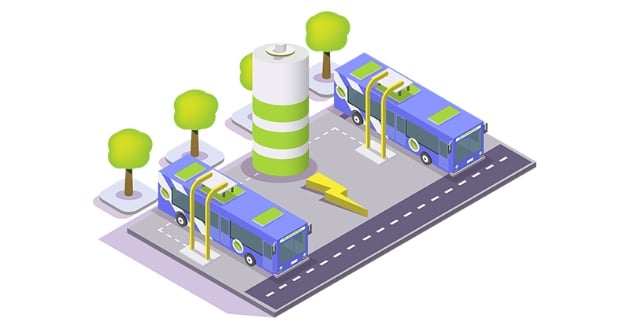
Table of Contents
Executive Summary
HD OBD CCR 1971.1 applies to vehicles with a gross vehicle weight of greater than 14,000 pounds. It applies to gasoline spark ignition (SI), diesel (compression ignition (CI)), alternate fuel (SI/CI), and hybrid vehicles. A very extensive on-vehicle diagnostic capability is required to identify and report malfunctions, notify the operator via the malfunction indicator lamp (MIL), and provide a standard service scan tool interface to allow the vehicle to be efficiently repaired. The manufacturer of record for the On-Board Diagnostics (OBD) systems must provide detailed certification testing results, detailed documentation fully describing the OBD system in order to get certified, and perform several different forms of postproduction testing and reporting requirements to stay in compliance. The Zero Emission Powertrain (ZEP) Certification and Green House Gas 2 (GHG2) certification, developed and codified by ARB in 2019, contain voluntary certification paths that require a set of diagnostics that are a small subset of heavy-duty onboard diagnostics (HD OBDs). The rules contain required diagnostics, standardized battery capacity testing, scan tool interface or equivalent, service material and tools access, and warranty reporting and commitment to take action if warranty reaches a defined failure rate are all required if Enhanced Electric and Fuel-Cell Vehicle Certification is pursued. One could speculate that the voluntary action really amounts to a Hobson’s choice If ZEP and Enhanced Electric and Fuel-Cell Vehicle Certification is what is necessary to secure the California customers due to a desire to be green, or to be able to be eligible for the Hybrid and Zero-Emission Truck and Bus Voucher Incentive Project (HVIP), or to win a contract for new business. This blog post provides more detailed information on the rules mentioned here and explains LHP’s experience in these areas. It also points out the need for executive-level leadership to put an “OBD culture” in place, and offers opinions on what it takes to do this work this efficiently.
Where Do These OBD Rules Come From?
The California Air Resources Board (CARB, or as many refer to it, ARB) has been evolving the OBD Regulations for nearly 30 years. The evolution has happened in the US as well as around the world. ARB is the recognized leader in the definition of these OBD regulations. LHP employs highly-experienced resources who have been involved with OBD for up to 28 years. ARB has followed a process where they are revising the OBD rule for vehicles below 14,000 pounds – CCR 1968.2 (California Code of Regulation) – about every 2 to 4 years since the 1992 timeframe. ARB began by calling these bi-annual reviews, but that changed as the years went by. ARB completed a Heavy-Duty OBD (HD OBD) rule in 2006 with the first compliance year in 2010 for the first engine family and fully phased in all families by 2016. The HD OBD rule is applicable to engines that go into vehicles above 14,000 pounds. This HD OBD rule is also updated about every 2 to 4 years. ARB does major updates to the OBD II in one rule making with minor updates to HD OBD, and then the next time does major updates to HD OBD and minor updates to OBD II rule. Major hybrid monitoring requirements were added to the OBD II rule that was official from California Office of Administrative Law (OAL) in 2016. Those hybrid monitoring requirements, plus some, were put in HD OBD rule that was official from OAL in October of 2019.
What Is OBD, Anyway?
OBD regulations have 4 main areas of requirements: 1. powertrain diagnostic design and development; 2. operator and service interface; 3. testing to be done for certification; and 4. postproduction testing at the vehicle level. The first main area is what must be done to monitor for malfunctions of sensors, actuators, controllers, and systems (emission or performance related). This is required for the engine, aftertreatment, transmission, and hybrid systems. The overall HD OBD rule has roughly 124 required component/system monitoring requirements shown in the ARB-provided “Diesel Monitor Checklist” – not including what has been added for hybrids. In addition to those 124, there is a Comprehensive Component Monitoring (CCM) section in this checklist to capture each input component and each output component. For each sensor (input) there are six monitoring requirements, and for each actuator (output) there are four monitoring requirements. It is rare to find a sensor or actuator in the powertrain of the vehicle that is not required to be monitored by OBD. The second main area provides for a malfunction identification lamp (MIL) that is amber in color and is an engine icon. The service interface provides a standard diagnostic tool connector to be used, a standard protocol with hundreds of parameters and many messages to supply service providers with a wealth of information that the OBD system must support (e.g., live data, drive cycle data, historic data). The third main area is that which requires the manufacturer to do durability demonstration testing in an emissions certification test cell. The test results confirm the emissions threshold monitors are calibrated to the proper OBD thresholds, that all of the OBD data that is communicated from the OBD control modules are coherent with the tests and results that are captured for submission to ARB. These tests are all performed using an End-of-Useful-Life engine and aftertreatment system, testing with a good End-of-Useful-Life part and then with the perfectly failed part (i.e., malfunction to be detected present). The fourth main area is the postproduction testing and reporting that is required. Here the manufacturer must run tests, gather data, and report using ARB-defined and provided templates. There are three (OBD II) or four (HD OBD) postproduction areas of results to report. They are categorized as Production Vehicle Evaluation (PVE) Scan Tool Interface (STI) results, PVE Monitor Demonstration (DTC) Results, PVE In-Use Monitor Performance Ratio (IUR), and HD OBD Verification of In-Use Compliance (IUC) test results. These can be referred to as: PVE-STI, PVE-DTC, PVE-IUR, and PVE-IUC, respectively.
To sum up OBD in a short paragraph, it requires the monitoring of all inputs and outputs, and control system functions (e.g., electronic, mechanical, chemical) to make the vehicle run at the correct emission and/or fuel/energy efficiency level. It requires illumination of a lamp to let the operator know a malfunction is present (i.e., the Malfunction Indicator Lamp (MIL)). It requires the use of a standardized communications interface (protocols and connector) to allow connection of a nonmanufacturer-specific scan tool to diagnose and troubleshoot the vehicle powertrain.

What Requires the Manufacturers to Make Service Information Available?
A product having to comply with OBD must also comply with the Service Information Regulation (SIR) CCR1969. SIR makes sure that all the necessary service information, service tools (mechanical and electronic), training and website access are available at a reasonable cost to an independent repair shop. Everything available to the manufacturers service channel must be made available to the independent service provider. This includes doing software and calibration updates through the OBD connector. Additionally, the original equipment manufacturer must make available for sale – under contract if desired – the design information, so an independent tool manufacturer can implement the enhanced diagnostic capabilities. Most manufacturers, if not all, utilize enhanced diagnostic capabilities in their dealerships.
How Do We Know This OBD Works Correctly in the Real World?
In addition to the base OBD rules, HD OBD and OBD II, ARB has coupled enforcement rules. The HD OBD enforcement rule is CCR 1971.5, and OBD II enforcement rule is CCR1968.5. These enforcement regulations identify specific OBD requirements, that if found to be not operating correctly, will lead to voluntary, influenced, or mandatory recalls. The enforcement documents identify testing that ARB and/or the manufacturer may be required to perform to determine the magnitude of the OBD non-compliance issue. Additionally, the enforcement regulations lay out specifically what is required if a manufacturer is having to perform one of the recalls mentioned above. The recall process is tightly controlled by ARB, including reviewing of the content of the information sent to the vehicle owners and absolute clarity on who must pay for the changes to fix the issue. ARB requires that these recalls have a Department of Motor Vehicles (DMV) tie in so that the repairs are sure to be made before the next annual registration of the vehicle/engine/hybrid.
What is LHP’s experience?
Manufacturers that must comply to OBD regulations benefit immensely from robust and efficient OBD development and maintenance processes. Included in those processes are: requirements management, design, release, change control, test, and quality systems. Many companies have found that the ownership of the malfunction detection algorithms belongs with those responsible for controls for that system. A goal of any manufacturer is to achieve a steady and controlled improvement of their products, controls, and diagnostics. Ideally, what is learned on one product line can then be used to improve all product lines and inform future generations of the products. In other words, avoid making the same mistakes on new products.
LHP has been involved with controls, OBD and diagnostics in general on engines (diesel, gasoline, alternate fueled), hybrids, and electric vehicles. This involvement has included participation in rule making, requirements definition (HW and SW), algorithm development, integration testing, certification testing, certification document preparation, certification discussions with ARB, running changes, field fixes, and postproduction required testing. LHP has the knowledge and resources to help you develop your company’s “OBD culture,” and put in place the kind of systems and processes to manage this complex work efficiently.
Why Is Executive-Level Involvement Required? Can’t Engineering Just Take Care of It?
OBD and regulated diagnostics needs to be sure to have executive-level management fully engaged in knowing what obligations there are to the regulators when getting OBD or ZEP or GHG2 certified. The implications are significant and involve many parts of the organization, including research, engineering, service, warranty, certification, change control and compliance. There are monetary penalties assigned at certification if the product is not fully compliant to OBD and ARB has declared the shortcomings as deficiencies. ARB must receive commitment to pay the fines before OBD Certification Approval is awarded. Additionally, on-board diagnostics impact warranty. There are warranty reporting requirements for OBD- and ZEP-certified products. Warranty reporting can identify issues that lead to an ARB-involved recall, correcting the issue for all applicable customers. ARB requires that these recalls have a Department of Motor Vehicles (DMV) tie in. Essentially, the vehicle owner can’t register their vehicle for the next year until the required repairs are made. So, what this illustrates is the wide-ranging impact of regulated OBD and diagnostics; thus, the need for executive-level involvement to put in place an “OBD culture” and make sure the appropriate leaders take on the new responsibilities that regulated on-board diagnostics impose.
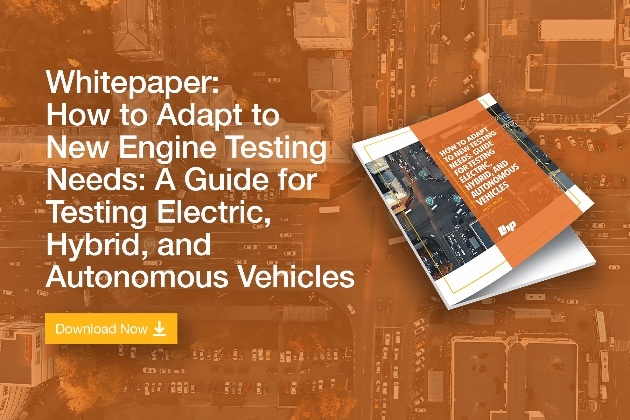
What Is the Latest on the Heavy-Duty OBD Rule, Impact on Hybrid Electric Vehicles (HEVs), and Electric Vehicle Diagnostics?
The heavy-duty OBD or diagnostic regulations have evolved over the last 20 years. The requirements HD OBD imposes are numerous and onerous. The information below identifies some of the big changes that have occurred with the October 2019 release of the regulation from the California Office of Administrative Law (OAL).
New Revision of CCR 1971.1 as of October 2019 – Big Changes Include:
What is ARB requiring? If the electric or fuel cell vehicle original equipment manufacturer (OEM) wants to claim a zero-emission powertrain (ZEP) then they need to meet the ZEP Certification requirements. The anticipation is that more environmentally conscious customers will want zero emission vehicles. Additionally, the bids on government projects may require zero-emission vehicles be proposed to satisfy bid requirements. California may start requiring this type of certification to be able to be eligible for HVIP (Hybrid and Zero-Emission Truck and Bus Voucher Incentive Project). LHP can help you understand the requirements your system must meet to get you ZEP certified and open the doors to some of these other opportunities. The ZEP certification requires more than just the diagnostics. LHP can help in those areas as well.
The table below contains some of the specific citations that are related to the kind of system and diagnostic information ARB requires the ZEP certified products to support.
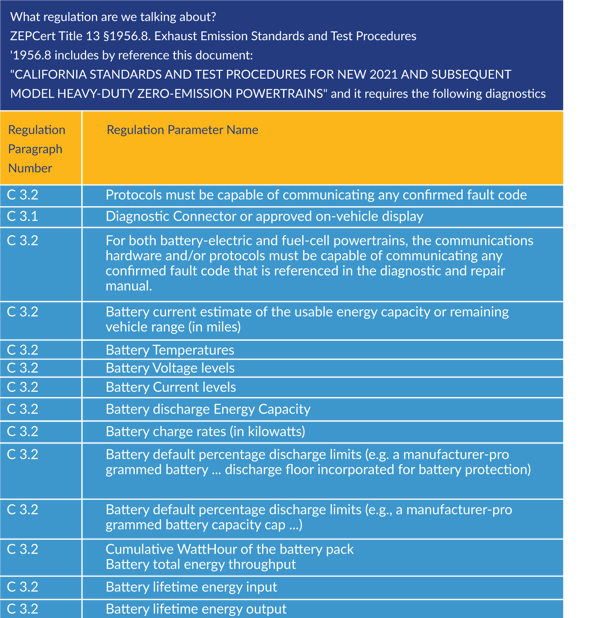
Industry worked with ARB to identify a set of message and parameters that should be supported for ZEPS. This information is shown below and is desired to be communicated by the system and for each battery pack. SAE J1939 (Society of Automotive Engineers) has defined message and parameter support for the system and up to 10 battery packs.
J1939 Table of Message (PG – Parameter Group) and Parameter (SP Suspect Parameter) Support for ZEPS
Note: This is the set of PGs and SPs for the system. The same type of information is defined for up to 10 battery packs. So, 5 PGs with a total of 11 SPs per system and per pack for a total of 55 PGs and 121 SPs
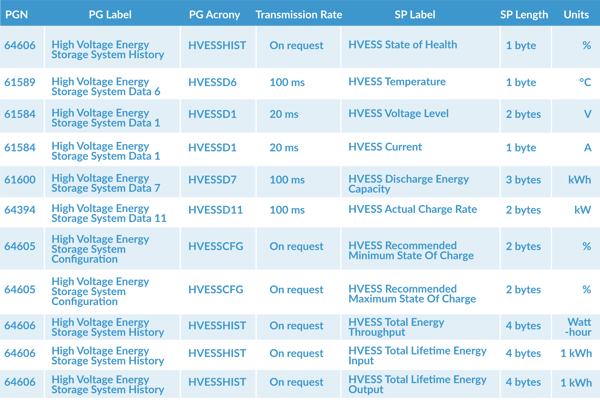
The document included by reference in the ZEP certification rule contains requirements for quantifying battery capacity in a standard way. That way is defined in the Society of Automotive Engineers (SAE) J1798, “Recommended Practice for Performance Rating of Electric Vehicle Battery Modules,” last revised on July 8, 2008, and was incorporated as a requirement to be satisfied. There are additional requirements for service information and for warranty, warranty reporting, and recall procedures – similar to that for emission-regulated vehicles. See the Warranty and Recall Requirements sections below.
Heavy-Duty Zero-Emission Powertrain Warranty and Recall Requirements
(page C15 to C32)
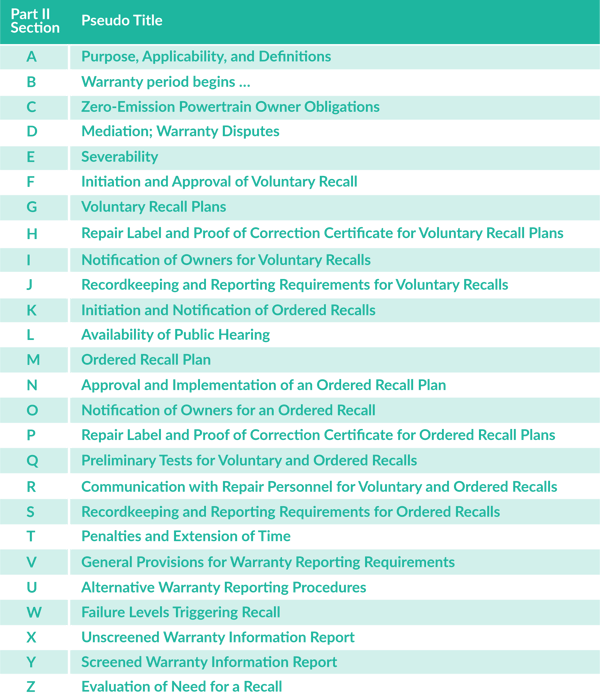
Is this different than ZEP certification? No and Yes. You will need to be ZEP certified to meet the GHG2 Diagnostic Requirements. So, if you want to be GHG2 certified in California and you want Enhanced Electric and Fuel-Cell Vehicle Certification then you must meet the GHG2 diagnostic requirements. If you do not, then you don’t have to. We can help you figure this out and have your vehicle system ready for certification with ARB.
ARB has added many GHG2 requirements that go beyond what the US Environmental Protection Agency (EPA) has required. The document titled “CALIFORNIA GREENHOUSE GAS EXHAUST EMISSION STANDARDS AND TEST PROCEDURES FOR 2014 AND SUBSEQUENT MODEL HEAVY-DUTY VEHICLES” contains the EPA sections but adds a paragraph A (whether EPA content is applicable or not) and B. Paragraph B is for ARB changes or additions. Below are the sections that apply to diagnostics functionality.
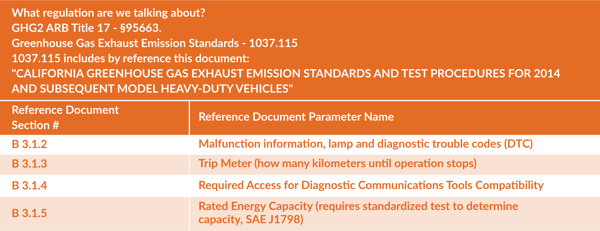
Industry worked with ARB to identify messages and parameters that should be supported for ZEP vehicles. This information is shown below and is desired to be communicated by the system and each battery pack. Society of Automotive Engineers (SAE) J1939 has defined message and parameter support for the systems used in these ZEP certified vehicles.

Interested in learning more about electric and hybrid vehicles, download the following whitepaper:
This whitepaper explores the challenges the industry is facing as this shift happens, particularly when it comes to testing the multitude of technologies needed during this transitional time and how companies can best prepare for a future where it is not yet clear which technology will prevail.
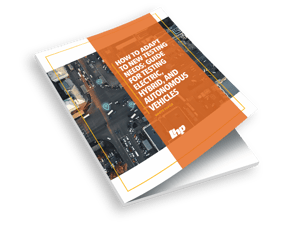

NI Drivven Powertrain Modules, Exclusively sold by LHPTS, an LHP division.
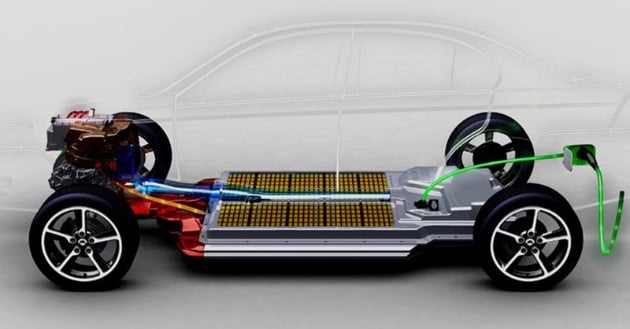
1 min read
When Toyota launched the first Prius in 1997, many consumers probably didn’t imagine that just 20 short years later the electric- and hybrid-vehicle...
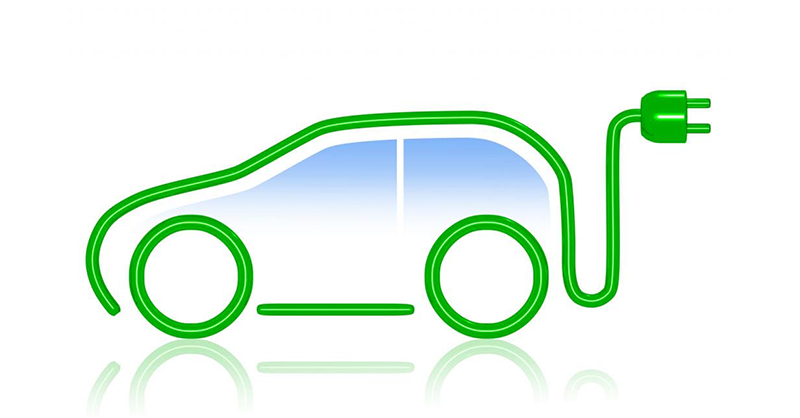
Will Autonomous and Electric Vehicles Kill the Fuel Industry? Did you know the first electric vehicle was introduced more than 100 years ago? Today,...